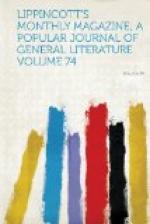There are blousards whose whole lives are passed in carving these toys from the wood of the linden tree, and daubing them with the most flaming reds, the most glittering yellows, the most dazzling blues, that ever colorist beheld. The toy whips with handles decorated with gilt paper wrapped about them spirally are said to be exclusively made by Israelites, but the ingenuity of the human mind has not devised an explanation of this curious fact. The papier-mache sheep is one of the most elaborately fashioned toys sold for a sou, and the mode of making it is this: The workman takes old scraps of paper and mashes them in water to a pulp: this he sticks around the inside of a rude mould, which is in two parts, one for each side of the sheep. When the two sides are moulded, he sticks them together and dips the whole in a pot of white mucilaginous paint. When this coating is dry, he tattoos the sheep according to his fancy, covers its back with a bit of sheepskin, and ties a red string around its neck. And all this work for a sou? is one’s incredulous question. Why, our blousard would think his fortune was made if he could get a sou for it. The retailer in the Rue Mouffetard sells it for a sou: the man who made it would be happy if he could sell it at the rate of eight sous the dozen, but, like most other workers, he must deal with a middleman. No retailer could take his stock off his hands in sufficient quantities: he must sell to a wholesale dealer in the first place, and the wholesale dealer sells to the little shopkeeper at eight sous the dozen. All this work for half a sou, then! And when it is added that the workman has to furnish the materials for his work besides, it really entitles the toy to a niche in the realms of the marvelous. I have found my eyes growing moist in New York as I listened to the tales of sewing-girls who made coarse shirts at six cents apiece, and found the thread, but such cases were exceptional, and could only be viewed in the light of intolerable hardships; while the poor wretches who make these toys at these prices are following the trade to which they were bred, and which their fathers followed before them, and their only fear is that they may be unable to get enough of this work to do. Each of the other toys in my collection is made at the same or a smaller price. The little lead candlestick is sold by the wholesale dealer at four sous the dozen. Whistles are sold at two sous the dozen. There are little watches of stamped brass with a crystal, movable hands, and a cord of yellow cotton with an occasional gold thread running through it, which are sold wholesale at seven sous the dozen.




